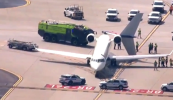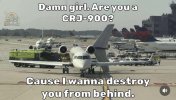Let'sgoflying!
Touchdown! Greaser!
Is it possible the 350 has damage way inboard of the wingtip - ie at the attachment?
Does it happen like this; the force applied to the tip can be inferred from known speed/location of damage to tip/extent of damage to tip then calculations made to find the effects on the rest of the wing?
Does it happen like this; the force applied to the tip can be inferred from known speed/location of damage to tip/extent of damage to tip then calculations made to find the effects on the rest of the wing?


